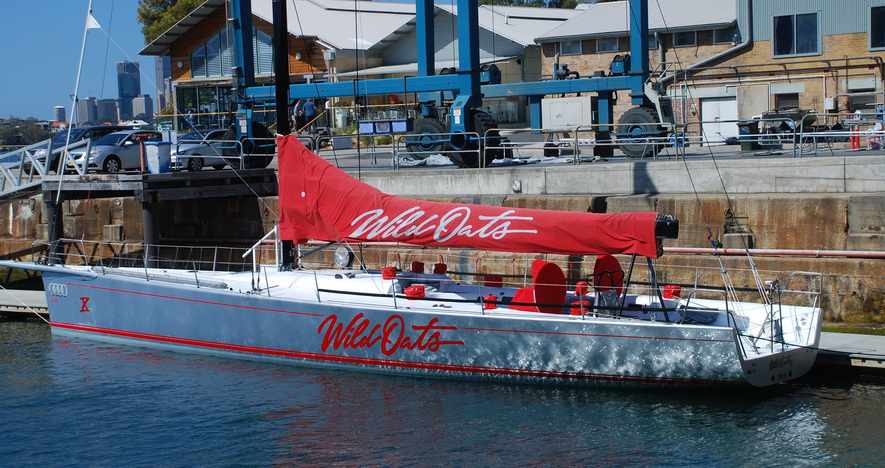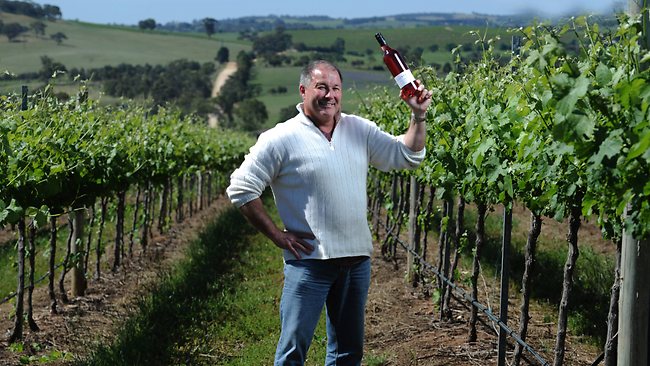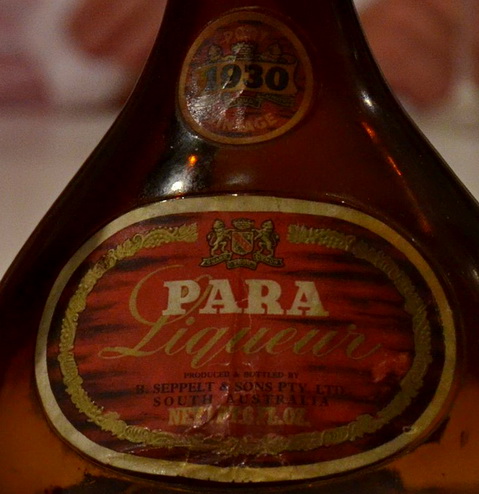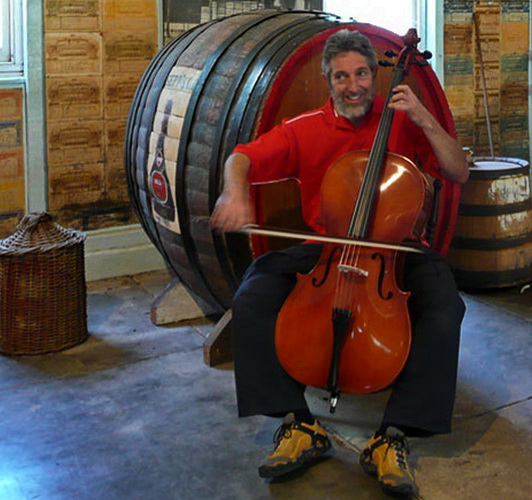From Migrant Family to Corporate Raiders and back
Another great name that fell into the greedy hands of corporate raiders, but this story has a happy ending, with new owners restoring Seppeltsfield to some of its former glory after it had been Southcorped, Rosemounted and Fostered over two decades.
I remember the first time I saw Seppeltsfield, on a glorious summer day. The long driveway lined by Canary Island Date Palms, the huge old bluestone buildings, the mausoleum for long-gone members of the family, and the majestic expanse of the place. Seppelt’s was one of Australia’s great wine dynasties, founded by Joseph Seppelt who came to Australia in 1849 from Silesia, a couple of years before modern Germany was defined in Frankfurt.
Joseph purchased a large property in the Barossa Valley and called it Seppeltsfield. It’s next to Marananga and Greenock, in an area that has an average annual rainfall of just 500 mm. Some of the world’s finest wine is made here, but Joseph planted tobacco at first because he’d been a snuff merchant back in Silesia.
From tobacco to Para Port
Tobacco was a failure so Joseph planted vines instead and had more luck. He began the construction of the full-scale winery in 1867 but died a year later. Son Benno took over at age 21. In 1878, to celebrate the completion of the grand bluestone port store, Benno selected a pipe of one of his finest port-style wines and declared that the 500l barrel would be allowed to mature for 100 years.
Every year from 1878 on, the Seppelts would set aside more of their finest wine for 100 years. In 1978, the first bottles of the 100 year old Para Tawny were released. As far as we know, Seppeltsfield is the only winery to have significant quantities of wine set aside in consecutive vintages covering a span of 100 years. This is an expensive process because the wine evaporates slowly – it’s called the angels’share in the trade – and needs frequent topping up with more of same or similar wine.
The biggest of them all
From what I can make out, Seppelt set up shop at Rutherglen in 1886, and this area became the source for most of their fabulous Muscats and Tokays. In 1889, Seppeltsfield saw the completion of a new gravity flow winery, a pretty radical concept that demonstrated the pioneering spirit which would remain a hallmark of the Seppelts. By the turn of the century, Benno had turned Seppeltsfield into the largest winery in the Southern hemisphere, if not the world. It accounted for one third of the entire wine production of the Barossa Valley, and exported large volumes of wine to the UK and Europe.
Although he was naturalized in 1866, Benno had to obtain exemptions in 1916 under the War Pre-cautions Act to continue in business. In the same year, Benno acquired the Chateau Tanunda and Lyndoch wineries. A couple of years later, he bought Great Western and its fabulous sparkling wine storage drives from Hans Irvine. In 1920, the output from Seppeltsfield reached one million gallons (4.5m litres). Benno was by now well into his seventies
Pioneering
Seppelt was the first company to plant vineyards at Keppoch/Padthaway in 1964, to meet the increasing demand for table wine. For a while there, Seppelt called their wines Keppoch, and Hardys Padthaway. A hundred years earlier, the land here was known as ‘Mosquito Plains.’ Eventually the waterlogged land was cleared for cropping and grazing, the huge redgums ending up as sleepers to support railway lines.
The CSIRO recommended the area for horticulture as far back as 1944 because of the rich soils, the underground water supply and the Mediterranean climate. It lies a little north of Coonawarra but lacks the rendzina, the famous red soil of that area. Lindemans, Hardys and Wynns followed Seppelts and planted large vineyards on the Limestone Coast as it’s now called. Today it supports 22 wineries, 250 growers and 15,800 hectares of vineyard.
As an aside, the Limestone Coast around Naracoorte saw one of Australia’s most significant palaeontological discoveries. In 1969, a huge silt deposit containing the remains of many tens of thousands of Pleistocene animals was found deep within the Victoria Cave. The Pleistocene period lasted from 1.6 million years ago to 10,000. A century earlier, the Reverend Tenison-Woods had found Pleistocene fossil bones here and seen them as evidence of the ‘biblical flood’ in Australia.
Bubbles
Karl Joseph Seppelt was the chief viticulturalist (and later the Managing Director) at the time, and he was also looking for cooler areas to plant Chardonnay and Pinot Noir for premium sparkling wine production. Drumbourg near Portland was one area Karl chose, and Partalunga in the Adelaide Hills was another a few years later.
The core of sparkling wine making remained at Great Western where Colin Preece was in charge. Preece had developed the unique Sparkling Burgundy style, but had also made some legendary reds. Like Max Schubert, he was a great blender, but also made the occasional straight Shiraz from Great Western. I was born in 1946 and shared a 1946 Seppelt Sparkling Burgundy with friends when I turned 40, and it was still all there. There weren’t a lot of bubbles, and the fruit was fading and giving way to interesting notes of dank mushrooms – much like on old Burgundy really.
 Southcorp and the graveyard of wine brands
Southcorp and the graveyard of wine brands
In 1971, B.Seppel t and Sons became a public company. Like many successful private companies, the family found it hard to raise the money needed to continue its expansion and to modernise its wineries. By now, these included great Western and Chateau Tanunda. In 1978, Seppelt released the first 100-year-old para liqueur port, an event that would be repeated every year.
In 1984 South Australian Brewing bought all the shares of Seppelts. It already owned Woodleys and Hungerford Hill. In 1990, SAB bought Adelaide Steamship’s wine business for just $400 million. Adsteam had acquired Tooth & Co in the eighties, which owned Penfolds, Kaiser Stuhl, Tulloch, Seaview, Wynns Killawarra and Tollana.
Hard to believe, SAB also bought Lindemans from Philip Morris the same year to become Australia’s biggest winemaker with more than one third of the market. The new entity was called Penfolds but its owners changed the name to Southcorp 4 years later. Southcorp bought Rosemount in 2001 for $1.5 Billion and made an unholy mess of the merger, which some called a reverse takeover.
Rosemount’s CEO Keith Lambert got the top job at Southcorp, which in 2003 was the seventh-largest wine business in the world. Just two years later, a united board that included his father-in-law Bob Oatley would ask for Lambert’s resignation. A tough outcome for a man described by a retailer as ‘walking, talking arrogance.’ ‘Lambert appears to have burned many he has come in contact with,’ Jeni Port wrote in The Age, ‘from the wine grower through to wine makers, marketers and distributors and possibly the most unforgiving of all, the investor.’
 At the operational level, the in-fighting between Penfolds and Rosemount factions rivalled a medieval costume drama, and many good people were lost in the process. Soon after Rosemount’s winemaker Philip Shaw was made chief winemaker, he fired Neville Falkenberg, Philip John and Geoff Henriks. Grange winemaker John Duval resigned in protest. These guys were among the best winemakers in Australia at the time.
At the operational level, the in-fighting between Penfolds and Rosemount factions rivalled a medieval costume drama, and many good people were lost in the process. Soon after Rosemount’s winemaker Philip Shaw was made chief winemaker, he fired Neville Falkenberg, Philip John and Geoff Henriks. Grange winemaker John Duval resigned in protest. These guys were among the best winemakers in Australia at the time.
Southcorp had more wine brands now than it knew what to do with, and many died for lack of attention. Grand old names like Seppelts, Lindemans and Wynns all ended up in this corporate graveyard of brands, with their destinies in the hands of brand managers who mostly had no sense of history or imagination.
Rosemounted
Lindemans simply died, Wynns nearly did until winemaker Sue Hodder and vineyard manager Allen Jenkins at Coonawarra took matters into their own hands. Seppelt went through a period where grand old labels like Chalambar and Moyston graced very ordinary wines. Southcorp had no idea what to do with Seppeltsfield. It already owned Penfolds with its iconic Grange, which had a much higher profile than even 100 year-old Para ports.
So Seppeltsfield languished, winemaking was transferred elsewhere, and Chateau Tanunda was closed. Penfolds’ fortified stocks were added to Seppelts as part of the rationalisation, but fortified wines were a connoisseur’s market by now.
Ben Canaider at The Age wrote a brilliant piece on the Rosemounting of Seppelts in 2002. ‘The “brand” has been “rebadged” along “elegant” lines,’ he said. ‘I wouldn’t call the new packaging elegant; I’d call it simple – supermarket simple. It might feature a crest and logo “derived” from the original Seppelt family crest, but the key word in all that is “derived”. In other words, it’s been “Rosemounted”.
‘Indeed, when you look at the table wine range, from top to bottom – St Peters, Winemakers Selection, Victorian Premier Reserve, and, finally, Classic Selection (in other words, the cheapies) – you can’t help but notice a resemblance to another range of wines, beginning with “R” … And some wines, like the occasionally stunning Drumborg Riesling, have disappeared. Pensioned off. Silly old goat reisling (sic).
‘The worst change yet ,’ Ben wrote, ‘is the way Seppelt might be getting lost in the PR vortex. Marketing euphemisms are in danger of obfuscating Seppelt out of normal existence. Terms from the brochures and uttered at the launch, such as “Rediscover the House of Seppelt and create your own tradition!” are nauseating. And being urged to “empower ourselves again” didn’t only sit oddly with wine, but made me feel like I was a rechargeable battery. As forward-thinking and freewheeling as Benno Seppelt may have been, he would struggle to understand the new message.’
‘Guard your honour,’ was the Seppelt’s family wine motto, Ben reminds us. Sadly, there’s no honour among these thieves.
Over the hill comes the cavalry, just in time
Fosters bought Southcorp in 2005 for $3.3 billion, made an even bigger mess of it and then got rid of the whole distracting wine business by spinning off a new corporate entity with the wonderfully bland name of Treasury Wine Estates in 2011. Meanwhile in 2007, a miracle happened when the Seppeltsfield Estate Trust bought Seppeltsfield from Fosters.
The people behind the trust were Kilikanoon Wines’ major shareholders – cellist and entrepreneur Nathan Waks, Bruce Baudinet, Janet Holmes a Court and Greg Paramor. They bought the historic Seppeltsfield site, winery, vineyards and visitor facilities, and the rights to the Para, Trafford, Old Trafford, Solero and Mt Rufus fortified wine brands. In addition, they got their hands on most the nine million litres of Seppelt fortified wines stored there.
Nathan Waks playing his cello in front of a cask of ParaLiqueur Port
Benno Seppelt’s old gravity-flow winery has been recommissioned after spending 30 years in mothballs. A cooper is back at work making barrels. Benno’s Kiosk now sells Seppeltsfield’s beers, brewed according to the 14th century ancient German beer purity laws. The grand gardens are being restored, but perhaps the best news is that fortified winemaker, blender and curator James Godfrey is still in charge of the treasure chest after 33 years at Seppeltsfield.
The Cavalry retreats
In 2009, McLaren Vale grapegrower Warren Randall bought Janet Holmes á Court’s share of Seppeltsfield, giving him 50% ownership of the estate. Philip White wrote that Warren Randall and his backers Warren Ward and Andrew Fletcher ‘are the largest private owners of vineyards at McLaren Vale, owning at least 20% of the district’s vineyards. Randall habitually buys vineyards which become available, provided they have full water licenses.’
The undertone in White’s words is not positive, and I’m not sure why. Randall was sparkling winemaker at Seppelts Great Western in the 1980s, and then worked with self-promoter Andrew Garrett who took over the old Wynns Romalo Cellars opposite Penfolds Grange vineyard in the eighties to make sparkling wine. Buying into Seppeltsfield gave Randall and partners access to old vine Grenache, says White, which has been in big demand following big raves for this variety from Robert Parker.
‘There has been intense, almost unseemly vineyard establishment around Seppeltsfield, Marananga and Greenock Creek,’ Philip White wrote at the time, adding that some of the new wineries included Two Hands and Torbreck. ‘Michael and Annabelle Waugh’s Greenock Creek wines began to attract the adulation of Robert Parker Jr. in the ’nineties,’ says White and adds that ‘Greenock Creek probably has more perfect scores from Parker than any other Australian winery. Its vineyards border Seppeltsfield on the north boundary.’
Just now in 2013, we read that Randall has acquired 90% of the business, because the owners of Killikanoon needed to refinance their operation, following years of growth from humble beginnings in the early nineties to 2000 hectares of vineyards all over South Australia. Time will no doubt tell what the true intentions of Randall and his friends are. Somehow, I felt more comfortable with the cellist and his partners (That said, Nathan Waks retains a financial interest and a seat on the board).
‘Since I worked for the Seppelt family in the 1980s as the champagne maker at Great Western, I have had a deep respect for Seppeltsfield,’ Randall told the Herald. ‘As Australia’s iconic wine estate, any owner of Seppeltsfield is purely a custodian guiding her through each decade. It is humbling to know however that Seppeltsfield is now under one family’s private majority shareholding – the first time since the Seppelt family’s era.’
 Warren Randell in the vineyards of Seppeltsfield
Warren Randell in the vineyards of Seppeltsfield
Let’s hope Warren Randall means every word of it.




